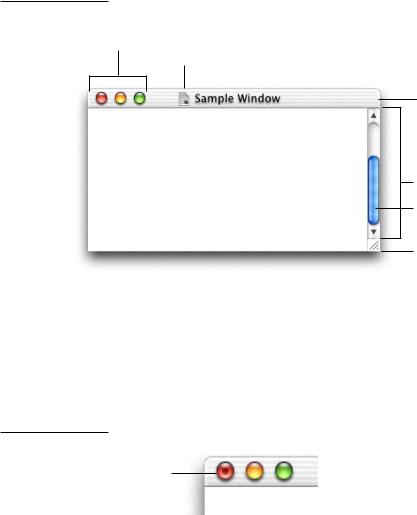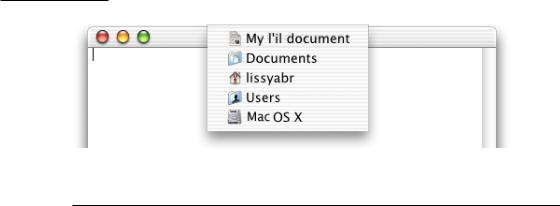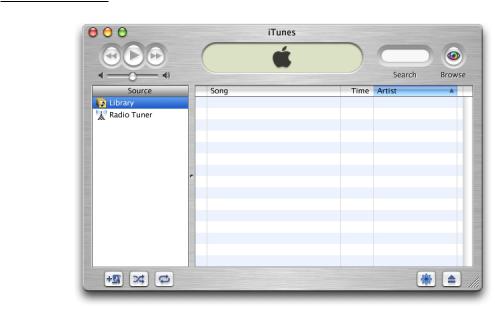
- •Contents
- •Figures and Tables
- •Introduction to the Aqua Human Interface Guidelines
- •The Benefits of Applying the Interface Guidelines
- •Deciding What to Do First
- •Tools and Resources for Applying the Guidelines
- •If You Have a Need Not Covered by the Guidelines
- •Human Interface Design
- •Human Interface Design Principles
- •Metaphors
- •See-and-Point
- •Direct Manipulation
- •User Control
- •Feedback and Communication
- •Consistency
- •WYSIWYG (What You See Is What You Get)
- •Forgiveness
- •Perceived Stability
- •Aesthetic Integrity
- •Modelessness
- •Knowledge of Your Audience
- •Worldwide Compatibility
- •Cultural Values
- •Language Differences
- •Default Alignment of Interface Elements
- •Resources
- •Universal Accessibility
- •Visual Disabilities
- •Hearing Disabilities
- •Physical Disabilities
- •The Dock
- •The Dock’s Onscreen Position
- •Dock Notification Behavior
- •Dock Menus
- •Clicking in the Dock
- •Menus
- •Menu Elements
- •Menu Titles
- •Menu Items
- •Grouping Items in Menus
- •Hierarchical Menus (Submenus)
- •Menu Behavior
- •Scrolling Menus
- •Toggled Menu Items
- •Sticky Menus
- •Standard Pull-Down Menus (The Menu Bar)
- •The Apple Menu
- •The Application Menu
- •The Application Menu Title
- •The Application Menu Contents
- •The File Menu
- •The Edit Menu
- •The View Menu
- •The Window Menu
- •The Help Menu
- •Menu Bar Status Items
- •Other Menus
- •Contextual Menus
- •Using Special Characters and Text Styles in Menus
- •Using Symbols in Menus
- •Using Text Styles and Fonts in Menus
- •Using Ellipses in Menus and Buttons
- •Windows
- •Window Layering
- •Window Appearance and Behavior
- •Textured Windows
- •Opening and Naming Windows
- •Positioning Windows
- •Closing Windows
- •Moving Windows
- •Resizing and Zooming Windows
- •Active and Inactive Windows
- •Click-Through
- •Scroll Bars and Scrolling Windows
- •Automatic Scrolling
- •Minimizing and Expanding Windows
- •Windows With Changeable Panes
- •Special Windows
- •Drawers
- •When to Use Drawers
- •Drawer Behavior
- •Utility Windows
- •The About Window
- •Dialogs
- •Types of Dialogs and When to Use Them
- •Document-Modal Dialogs (Sheets)
- •Sheet Behavior
- •When to Use Sheets
- •When Not to Use Sheets
- •Alerts
- •Dialog Behavior
- •Accepting Changes
- •The Open Dialog
- •Saving, Closing, and Quitting Behavior
- •Save Dialogs
- •Closing a Document With Unsaved Changes
- •Saving Documents During a Quit Operation
- •Saving a Document With the Same Name as an Existing Document
- •The Choose Dialog
- •The Printing Dialogs
- •Controls
- •Control Behavior and Appearance
- •Push Buttons
- •Push Button Specifications
- •Radio Buttons and Checkboxes
- •Radio Button and Checkbox Specifications
- •Selections Containing More Than One Checkbox State
- •Pop-Up Menus
- •Pop-Up Menu Specifications
- •Command Pop-Down Menus
- •Command Pop-Down Menu Specifications
- •Combination Boxes
- •Combo Box Specifications
- •The Text Entry Field
- •The Scrolling List
- •Placards
- •Bevel Buttons
- •Bevel Button Specifications
- •Toolbars
- •Pop-Up Icon Buttons and Pop-Up Bevel Buttons
- •Slider Controls
- •Slider Control Specifications
- •Tab Controls
- •Tab Control Specifications
- •Progress Indicators
- •Text Fields and Scrolling Lists
- •Tools for Creating Lists
- •Text Input Field Specifications
- •Scrolling List Specifications
- •Image Wells
- •Disclosure Triangles
- •Layout Guidelines
- •Group Boxes
- •Sample Dialog Layouts
- •Using Small Versions of Controls
- •User Input
- •The Mouse and Other Pointing Devices
- •Using the Mouse
- •Clicking
- •Double-Clicking
- •Pressing
- •Dragging
- •The Keyboard
- •The Functions of Specific Keys
- •Character Keys
- •Modifier Keys
- •Arrow Keys
- •Function Keys
- •Key Combinations Reserved by the System
- •Recommended Keyboard Equivalents
- •Creating Your Own Keyboard Equivalents
- •Keyboard Focus and Navigation
- •Full Keyboard Access Mode
- •Type-Ahead and Auto-Repeat
- •Selecting
- •Selection Methods
- •Selection by Clicking
- •Selection by Dragging
- •Changing a Selection With Shift-Click
- •Changing a Selection With Command-Click
- •Selections in Text
- •Selecting With the Mouse
- •What Constitutes a Word
- •Selecting Text With the Arrow Keys
- •Selections in Graphics
- •Selections in Arrays and Tables
- •Editing Text
- •Inserting Text
- •Deleting Text
- •Replacing a Selection
- •Intelligent Cut and Paste
- •Editing Text Fields
- •Entering Passwords
- •Fonts
- •Icons
- •Icon Genres and Families
- •Application Icons
- •User Application Icons
- •Viewer, Player, and Accessory Icons
- •Utility Icons
- •Non-Application Icons
- •Document Icons
- •Icons for Preferences and Plug-ins
- •Icons for Hardware and Removable Media
- •Toolbar Icons
- •Icon Perspectives and Materials
- •Conveying an Emotional Quality in Icons
- •Suggested Process for Creating Aqua Icons
- •Tips for Designing Aqua Icons
- •Drag and Drop
- •Drag and Drop Design Overview
- •Drag and Drop Semantics
- •Move Versus Copy
- •When to Check the Option Key State
- •Selection Feedback
- •Single-Gesture Selection and Dragging
- •Background Selections
- •Drag Feedback
- •Destination Feedback
- •Windows
- •Text
- •Multiple Dragged Items
- •Automatic Scrolling
- •Using the Trash as a Destination
- •Drop Feedback
- •Finder Icons
- •Graphics
- •Text
- •Transferring a Selection
- •Feedback for an Invalid Drop
- •Clippings
- •Language
- •Style
- •Terminology
- •Developer Terms and User Terms
- •Labels for Interface Elements
- •Capitalization of Interface Elements
- •Using Contractions in the Interface
- •Writing Good Alert Messages
- •User Help and Assistants
- •Apple’s Philosophy of Help
- •Help Viewer
- •Providing Access to Help
- •Help Tags
- •Help Tag Guidelines
- •Setup Assistants
- •Files
- •Installing Files
- •Where to Put Files
- •Handling Plug-ins
- •Naming Files and Showing Filename Extensions
- •Displaying Pathnames
- •Speech Recognition and Synthesis
- •Speech Recognition
- •Speakable Items
- •The Speech Recognition Interface
- •Speech-Recognition Errors
- •Guidelines for Implementing Speech Recognition
- •Speech Synthesis
- •Guidelines for Implementing Speech Synthesis
- •Spoken Dialogues and Delegation
- •General Considerations
- •Installation and File Location
- •Graphic Design
- •Menus
- •Pop-Up Menus
- •Windows
- •Utility Windows
- •Scrolling
- •Dialogs
- •Feedback and Alerts
- •The Mouse
- •Keyboard Equivalents
- •Text
- •Icons
- •User Documentation
- •Help Tags
- •Document Revision History
- •Glossary
- •Index

C H A P T E R 5
Windows
Window Layering
In Mac OS 9 and earlier, all windows belonging to a particular application are in the same layer. In Mac OS X, each document exists in its own layer, so documents from different applications can be interleaved. Clicking a window to bring it to the front doesn’t disturb the layering order of any other window.
A window’s depth in the layers is determined by when the window was last accessed. When a user clicks an inactive document or chooses it from the Window menu, only that document, and all open utility windows, should be brought to the front. Users can bring all windows of an application forward by clicking its icon in the Dock or by choosing Bring All to Front in the application’s Window menu. These actions should bring forward all of the application’s open windows, maintaining their onscreen location, size, and layering order within the application. For more information, see “The Window Menu” (page 61) and “Clicking in the Dock” (page 44).
Window Appearance and Behavior
Every document and utility window should have, at a minimum, a title bar and a close button. Even if the window does not have an actual title (a tools palette, for example), it should have a title bar so that users can move the window.
A standard document window has
■a title bar
■a resize control
■scroll bars (if not all the window’s contents are visible)
■close, minimize, and zoom buttons, although only the close button must be present at all times
70Window Layering
Apple Computer, Inc. June 2002

C H A P T E R 5
Windows
Figure 5-1 Standard window parts
Close, minimize, and zoom buttons
Proxy icon
Title bar
Scroll bar
Scroller
Resize control
When a document has unsaved changes, the close button should display a dot. Carbon developers should set this control with the SetWindowModified function. In Cocoa, this behavior happens automatically if the application is NSDocument-based; otherwise, use the setDocumentEdited: method of the NSWindow class.
Figure 5-2 The close button in its unsaved changes state
The dot indicates that this document
has unsaved changes.
Window Appearance and Behavior |
71 |
Apple Computer, Inc. June 2002

C H A P T E R 5
Windows
After a document is saved for the first time, a proxy icon appears in the title bar. Users can manipulate this icon as if they were manipulating the corresponding file-system object. For example, you can drag a document’s proxy icon to a folder in the Finder. A proxy icon appears in its normal state as long as the state of the document and the file system object are the same. When a document has unsaved changes, its proxy icon appears dimmed. Command-clicking the title or the proxy icon displays a pop-up menu illustrating the document path.
Figure 5-3 Document path pop-up menu, opened by Command-clicking the proxy icon
Textured Windows
Mac OS X version 10.2 provides developers with a new “textured” window appearance (see Figure 5-4). This window style has been designed specifically for use by—and is therefore best suited to—applications that provide an interface for a digital peripheral, such as a camera, or an interface for managing data shared with digital peripherals, such as the Address Book application.
This appearance may also be appropriate for applications that strive to re-create a familiar physical device—the Calculator application, for example. Avoid using the textured window appearance in applications or utilities that are unrelated to digital peripherals or to the data associated with these devices.
Within an application, the textured window appearance should be limited to the primary application window. Supporting windows, such as preferences and other dialogs, should not use the textured window appearance. It is acceptable to have a mix of standard Aqua windows and textured windows within an application.
If a textured window has a drawer or a toolbar, they automatically inherit the textured appearance. Sheets, however, maintain the standard Aqua appearance.
72Window Appearance and Behavior
Apple Computer, Inc. June 2002

C H A P T E R 5
Windows
Figure 5-4 The “textured” window appearance
The textured window has four rounded corners and a beveled edge surrounding the entire window. The beveled edge requires that elements such as lists and other view-type controls be inset at least 10 pixels. Users can move textured windows by dragging anywhere on the textured surface (not just the title bar).
Avoid creating custom controls for use with textured windows; standard controls look and behave appropriately when used with this appearance.
To create a window with this appearance, Cocoa developers can apply the NSTexturedBackgroundWindowMask to a titled window. Avoid using a borderless window, which won’t assume rounded corners. Carbon developers can use the new window type defined in MacWindows.h.
Window Appearance and Behavior |
73 |
Apple Computer, Inc. June 2002
